February 14, 2004
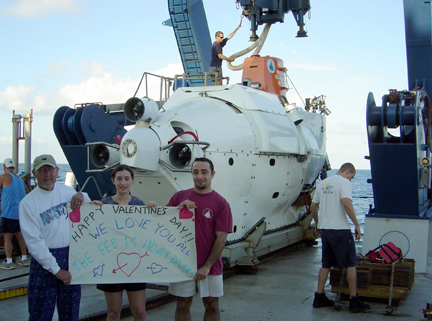
Ian Ridley, Clare Williams and Tony Tarantino (right), the Alvin Pilot on Dive 3971, spent Valentine's Day on the East Pacific Rise today. It was Clare's first Alvin dive. As a graduate student at Woods Hole Oceanographic Institution, it provided her with a unique opportunity to directly observe the seafloor she is studying for her doctoral research.
a
Adam Soule took this panoramic shot of the Main Lab today. The center of the photo is of the port bulkhead, to the right is looking forward and to the left is looking aft.
Today I experienced my first Alvin dive, with pilot Tony Tarantino and Ian Ridley. After the previous “interference” with first–timer’s dive bags that had occurred over the last couple of days I was very suspicious of my fellow shipmates last night when I went to bed. They did not let me down! Early this morning the Alvin crew complained that my dive bag was too heavy, due to three huge earth science and oceanography textbooks that had been added. Always considerate of weight issues in the sub, they were removed before the dive. However, we could have done with them when we reached the seafloor because Tony’s, Ian’s and my combined weight was not enough to keep the sub descending when we dropped the steel ballast , we stopped dead until Tony pumped some water into the ballast tanks.
The aim of our dive was to sample the large lava flow on the eastern side of the ridge axis near 9° 43.5'N. The flow shows up beautifully on the side scan image and we began where Mike and Javier had left off on Dive 3966, in a channel a couple of kilometers from the axis. Once we found the channel we turned west and headed “upstream” along the flat bed of the channel with banks of hackly sheet flows on either side. As we continued upstream the flat channel appeared to break into multiple smaller channels, divided by more banks of hackly flows and from that into smoother lobate flows. Before we turned back and headed east and downstream we crossed massive pillow basalts up to 5 meters in length with large collapses and sampled some of the lava buds on the sides of the pillows.
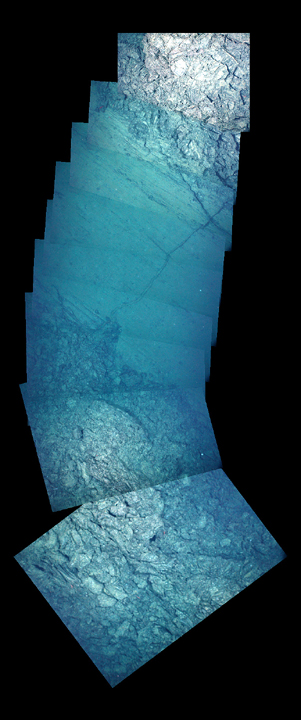
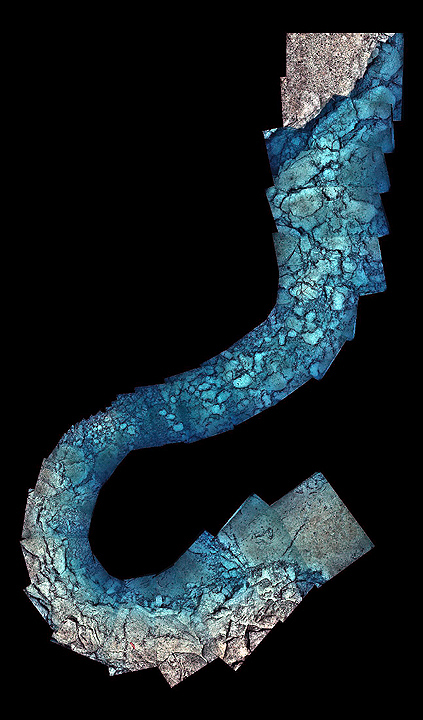
Examples of some of the mosaics we are making on board under the expert guidance of Yuri Rzhanov. Having these large scale perspectives, as we think about the processes that formed the lava channels and other volcanic terrain, is essential to the success of our work. The mosaic at left is of a crossing of part of a lava channel mapped on Dive 3968. The image area is approximately 3m x 15m. The right mosaic was made from digital downlooking photos collected by Alvin on Dive 3965.

Adam's panorama of the bow of the R/V Atlantis, looking aft. The level with all the windows in the center of the photo is the ship's Bridge.
Traversing down the channel to the east, we were back in hackly/sheet flow country again and lobate flows with huge collapses. We deployed Cara’s bioboxes and headed north to check out what we thought to be a fault scarp. When we arrived there was no scarp in sight, instead the morphology of the flows changed from hackely and lobates to heavily sedimented, smooth lobates and there were several large north-south trending cracks. This suggests that maybe a lava flow was hemmed in by a fault scarp some time in the past and the level of the flow rose just to the top of the scarp, therefore making it disappear. Further to the south the same flow seems to spill over the fault and the large cracks we observed are evidence that the fault is still moving. Unfortunately, shortly after flying over the smooth, sedimented lobates the sub’s power ran low and we had to finish our survey, but the fun was not over.
On our way back to the surface I discovered some more goodies in my dive
bag- a tube of sunscreen ( because you never can be too careful in the
pitch black?) and a pair of guy’s underwear (don’t worry,
they were clean). After Adam declined to wear the bra hidden his dive
bag a few days ago, I felt it was only polite to wear the underwear…
and get it thoroughly soaked from the ice water shower that greeted me
back on deck.
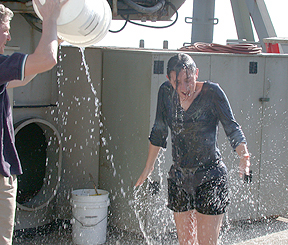
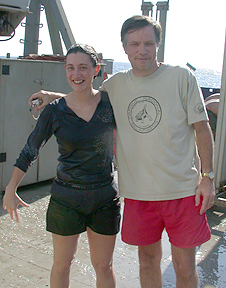
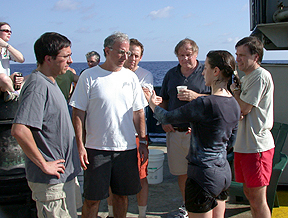
Clare getting doused. Note the lovely shorts she found in her dive bag... (center) Clare and Maurice Tivey, her advisor. Clare explaining the finer points of ternary space in the olivine field to Mike and Javier.

Another glorious sunset here at 9° 50'N on the EPR axis.
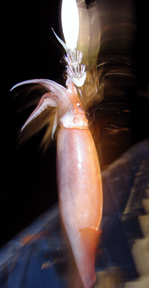 This
poor squid made the mistake of being attracted to the lights around Atlantis
last night during the camera tow. Schools of squid have been seen each
night along with flying fish and small mahi.
This
poor squid made the mistake of being attracted to the lights around Atlantis
last night during the camera tow. Schools of squid have been seen each
night along with flying fish and small mahi.
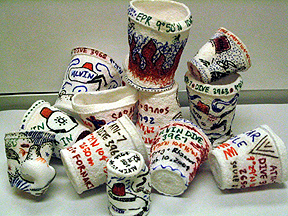
Adam Soule's collection of shrunken styrofoam cups. The cups are designed at full size on the surface and placed in a bag outside of Alvin, during dives. The immense pressure at the sea floor causes the air to "squeeze" out of the foam and the cups compress to a miniature size.